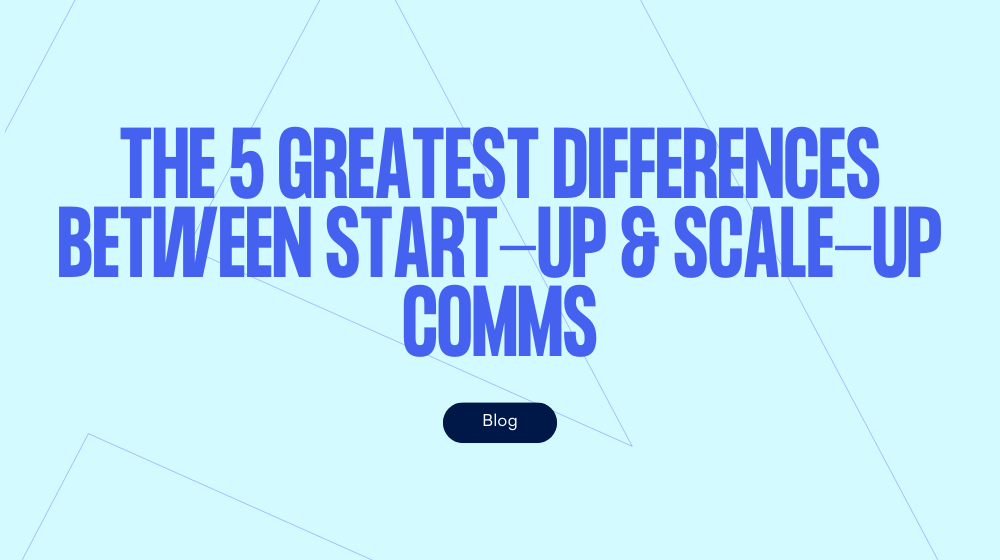At some point during the journey of a start-up business, if it doesn’t crash and burn in a ball of flames, it may turn into what is called a “scale-up.” Although they may sound similar, there are some big differences between the two…
While start-up businesses are tackling the gruelling task of developing products or services for market and desperately trying to stay afloat, scale-ups have moved past all that. To use a professional term, they’re “killing it.”
According to the 2014 Scale-Up Report on UK Economic Growth: “Scale-ups are enterprises with average annualised growth in employees (or in turnover) greater than 20 per cent a year over a three-year period, and with 10 or more employees at the beginning of the observation period.”
Naturally, there are also key differences between how start-ups and scale-ups need to approach their PR and marketing. Start-ups rarely have the skills or capacity for fully blown comms brilliance (although that doesn’t stop some of them from achieving it). Scale-ups, meanwhile, are typically well on the rise and should have their comms in order. They should have found their niche, know who to target and be working to bring the two together. Here’s how some of the differences between start-up and scale-up communications shape up…
Budget
Many (but not all) start-up businesses survive off a boot-strap budget. When it comes to PR and marketing, it’s crucial that start-ups get the most out of what little budget they have and find inexpensive ways to get themselves in front of the right people in the right places at the right times. Activity can often be spontaneous and tactical rather than planned and strategic.
Not so for scale-ups - you need to have your strategy and spends down. That can be daunting, especially if you’ve not created a comms strategy previously, but it’s not as complicated as many people think. The trick is to be smart in where you allocate resources – look at your objectives, your audience and your learnings to date. Do what you know works and try things that you think might so as to keep improving the return on your comms investment. Test, learn and iterate quickly.
Objectives
Most business start-ups begin with one main objective – to survive. If you’ve got past that hurdle and bloomed into scale-up territory, the objective is often growth, growth, continued growth and more growth. Of course, there’s a difference between knowing where you’re going and actually getting there, though.
As a scale-up, you need to be fast and focused, with simple finish lines that are chased down in short sprints. The length of each sprint is down to what suits your company, but the approach lets you plan quickly, deliver quickly and review quickly. As this breathless analogy explains, the scale-up mindset is all about fast iteration, with the outputs of one sprint informing the goals of the next.
Data
Unlike start-ups, wandering aimlessly around the bewildering comms landscape, scale-up businesses should have got their bearings and be marching around purposefully with a clear idea of where they’re heading.
They should also have a comms journey to-date to reflect on. Reviewing and analysing this helps scale-ups to understand what has worked, what hasn’t and using those insights to plan what their route ahead looks like. Learning from mistakes made along the way is also, obviously, a marvellous idea. Ask yourself: what impact has the past and current communications had on lead generation? How well do we know our customers? What goals have been achieved?
Audience
While start-ups may not necessarily know who they should be speaking to, scale-ups should already be charming their key contacts. This means you should know everything about your audience so you can tailor what you say accordingly.
You need to know as much about their jobs as they do, their day-to-day activities, their challenges, what they read, where they hang-out, who they listen to and what would make their lives easier. The picture you build up with also this info is called a “persona” and all of your comms activity should stem from the personas you are targeting. They’re key.
Social
Knowing the personas you need to target, as you of course do(…), you can engage with them on social media. Using social media as a start-up can be tricky – Facebook is generally used to reach the masses, but that doesn’t mean to say it’s right for growing a business that wants to build valuable, genuine connections. Choose the platforms that suit your business.
As a scale-up, your social media strategy should be more focused. Chat to the people who matter and build up a community with them. Disregard those who aren’t relevant, like the cold, growth-focused business that you are. But be nice about it. Manners cost nothing.




